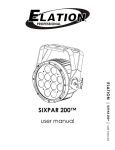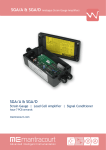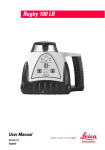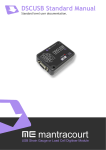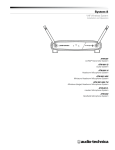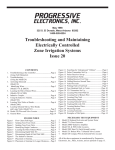Download Triplett Railroad Testers 2000 Series
Transcript
TRIPLETT 2000 Series Type 3 Railroad Test Sets Instruction Manual Model 2000 Model 2001 Model 2002 Model 2003 84-873 7/07 SAFETY RULES Warning This Tester has been designed with your safety in mind. However, no design can completely protect against incorrect use. Electrical circuits can be dangerous and/or lethal when lack of caution or poor safety practices are used. Read the Manual Read this Instruction Manual carefully and completely. Voltages and currents within the capability of this test equipment can be hazardous. Follow the instructions in this manual for every measurement. Read and understand the general instructions before attempting to use this tester. Do not exceed the limits of the tester. Safety Check Double check the switch setting and lead connections before making measurements. Are you following all of the instructions? Disconnect the tester or turn off the power before changing switch positions. Do not connect to circuits with voltage present when switch is in any ohms or current position. When replacing fuses, use only specified type fuses and insert in correct fuse holder. Page 2 Don't Touch Don't touch exposed wiring, connections, or other "live" parts of an electrical circuit. If in doubt, check the circuit first for voltage before touching it. Turn off the power to a circuit before connecting test probes to it. Be sure there is no voltage present before you touch the circuit. Do not use cracked or broken test leads. High Voltage Is Dangerous Always start with the power off. Be sure there is no voltage present before making connections to the circuit. Don't touch the tester, its leads, or any part of the circuit while it is on. Before disconnecting the tester, turn the circuit off and wait for the meter to return to "zero". Distribution Circuits Pack a Punch In high energy circuits such as distribution transformers and bus bars, dangerous arcs of explosive nature can occur if the circuit is shorted. If the tester is connected across a high energy circuit when set to a low resistance range, a current range, or any other low impedance range, the circuit is virtually shorted. Special equipment designed for use with these circuits is available. Contact a qualified person for assistance before attempting to make measurements on any high energy circuit. Safety Is No Accident Note: Specifications subject to change without notice. Page 3 TABLE OF CONTENTS SAFETY RULES 2 1.0 INTRODUCTION 6 2.0 PRODUCT FEATURES 8 2.1 Code Measurements 8 2.2 The Cab Filters 10 2.3 Auto-Polarity 10 2.4 Power Supply Features 10 3.0 PREPARATION FOR USE 12 3.3 Meter Mechanical Zero 13 3.4 Visual Inspection of the Test Set 14 3.5 Visual Inspection of the Test Leads 14 3.6 Battery and Fuse Test 15 3.7 Battery and Fuse Replacement 18 Page 4 4.0 GENERAL OPERATION 20 5.0 OPERATION 22 5.1 Measuring AC and DC Voltage 22 5.2 Measuring DC milliAmps 24 5.3 Measuring DC and AC Amps 26 5.4 Measuring Resistance 28 5.5 Measuring Dry Contacts 32 5.6 Measuring DC Pulse Code Signals 33 6.0 SPECIFICATIONS 34 6.1 Electrical Specifications 34 6.2 Physical Specifications 43 7.0 ACCESSORIES, PARTS, AND SERVICE 44 8.0 LIMITED WARRANTY 48 Page 5 1.0 INTRODUCTION 1.1 Package Contents The standard shipping package contains the following items: Test Set Test Leads This Instruction Manual Carrying Case with Strap Spare Fuses Two, 9V Alkaline Batteries One, D-cell Alkaline Battery 1.2 Product Description The Model 2000 Series of Railroad Test Sets are specialized VOM's designed for measuring the signal parameters of railroad coding equipment. They maintain compatibility with older technologies, while at the same time, offering functions and features not found on standard VOM's. 1.2.1 Easier to Use for Normal Operation Fewer jacks, more ranges, and a logical layout of the front panel all contribute to the Test Sets' ease of use. The use of a multi-turn Ohms Adjust Control facilitates accurate resistance measurements. Also, the measurement of relay contact on time requires no adjustments. Page 6 1.2.2 Measurement of Code Parameters The measurement of code parameters has been made simple and accurate. No longer is it necessary to count pointer swings to measure code rate. On time can be measured on live signals as well as relay contacts. Peak levels can be determined quickly and automatically. Adjustment to the code equipment peak level can also be made without constantly readjusting the Test Set. 1.2.3 Expandable Optional circuit boards may be installed to allow for the filtering of 60 Hz, 100 Hz, 200 Hz, or 250 Hz cab signals. The base unit may be upgraded at any time to include these filters without loosing the initial investment. 1.2.4 Four Models The 2000 Series currently consists of four models. The base Model 2000 has all the features mentioned above with the exception of the Cab Filters. The Model 2001 includes selectable 100 Hz and 250 Hz Cab Filters. The Model 2002 includes selectable 100 Hz and 200 Hz Cab Filters. The Model 2003 includes selectable 60 Hz and 100 Hz Cab Filters. 1.2.5 Selectable DC Amps Polarity The DC Amps function has selectable polarity. This is useful for measuring the transmit and receive currents in pulse coded track circuits. Page 7 2.0 PRODUCT FEATURES 2.1 Code Measurements Code parameters may be directly measured with the Test Set. These code measurements are active in any AC or DC voltage or current range, as well as the Dry Contact function. These functions are selected by placing the Code Function Switch in the desired position. The Pointer will momentarily return to zero and then indicate the appropriate reading. If the Range Switch or any other switches are changed, then the measurement circuitry is automatically reset and made ready for the new measurement. 2.1.1 Peak Hold This function will capture and hold the peak level of the signal. If the peak level of the signal is varying slightly, the Test Set will average 25 of these readings to give an average peak level. For DC functions, the polarity of the peak is also captured and displayed using the NEG Indicator. For the Dry Contact Range, Peak Hold will capture and hold a momentary contact closure. CAUTION: The 2000 Series Type 3 will continue to read out the averaged value of the last captured measurements, even after the signal has been removed. The value will continue to be read out until a new signal is captured or the Test Set is reset by changing the setting of the Code Function switch or the Range switch. Page 8 2.1.2 Peak Follow This function is similar to Peak Hold, except the peak measurement will follow the peak level automatically, even if it is decreasing. This permits easier adjustment of peak levels. No averaging is performed, so if the peak level is varying, the Pointer will follow it. WARNING: The 2000 Series Type 3 will continue to read out the value of the last captured measurement, even after the signal has been removed. The value will continue to be read out until a new signal is captured or the Test Set is reset by changing the setting of the Code Function switch or the Range switch. 2.1.3 Rate This function directly measures the rate of the signal. The result is displayed on the CODE RATE scale. Only after two readings are taken and found to be close together, does the Pointer deflect. It may require up to eight seconds for the reading to be updated if the rate changes. This reduces the possibility that noise may cause a false rate indication. Also, the peak signal level must be at least 10% of full scale for the measurement to be made. The rate of the highest level signal of either polarity is displayed. 2.1.4 On Time This mode is similar to the Rate function, except the percentage of time that the signal is on is displayed. The on time is read using the "%" scale. Nominal Code Rate is 50% duty cycle. Page 9 2.2 The Cab Filter If the Test Set has Cab Filters, then all AC functions may select one frequency to be measured. This is invaluable when multiple cab signals are being sent, as it negates the need to turn off one of the cab signals to measure the other one. The Signal Select Switch is simply placed in the position indicating the frequency to be measured. All functions behave the same, except that only the signal of interest is measured. 2.3 Autopolarity 2.3.1 Auto-Polarity For all DC functions, the Test Set works in the auto-polarity mode. The highest level peak of either polarity and its timing parameters will be measured. In this mode, the Pointer will always deflect upscale, with the NEG Indicator lighting for signals of negative polarity. The highest level peak of either polarity and its timing parameters will be measured. 2.4 Power Supply Features 2.4.1 The Sleep Feature Since the Test Set relies on batteries for operation, a battery saving feature has been incorporated to extend the battery life if accidentally left on. This is known as the Sleep mode. After approximately five minutes of non-use (Pointer at less than 1% of scale and no range switch changes) the Test Set will power down, reducing battery drain and extending battery life. This mode is indicated by the Pointer deflecting down scale into the Sleep Zone. To reactivate the Test Set, simply rotate the Range Switch. NOTE: DURING SLEEP, THE TEST SET WILL NOT RESPOND TO ANY INPUT. Page 10 2.4.2 Battery Monitor To prevent operation of the Test Set with weak batteries, a battery test is performed every time the Range Switch is changed. If the batteries are low, the Pointer will deflect down scale into the Sleep Zone. It will not respond to any input making measurements impossible. This feature prevents low batteries from providing false readings if they fall below a voltage at which the internal circuitry is designed to operate reliably. Note that even though the Pointer is in the Sleep Zone, the Test Set is not in a low current mode. After approximately five minutes, the Test Set will revert to the battery saving Sleep mode. 2.4.3 Sleep Mode Disable The Test Set contains a field changeable jumper located on the left of the small circuit board on the bottom of the large main circuit board. This is found by removing the four screws holding the RF shield. This jumper, when in position 1-2, will enable the sleep mode. To disable the sleep mode, move the jumper to the 2-3 position. Page 11 3.0 PREPARATION FOR USE 3.1 Before using the Test Set, familiarize yourself with the instrument and this manual. READ AND REVIEW THIS MANUAL FREQUENTLY. 3.2 Each time the Test Set is used, check, and if necessary, correct the mechanical zero of the meter. Refer to Section 3.3. Inspect the Test Set for mechanical defects as described in Section 3.4. Also, inspect the test leads as described in Section 3.5. Finally, perform the Battery and Fuse Test as described in Section 3.6. Only after all tests have been passed should the Test Set be used. DO NOT USE THE TEST SET IF ANY OF THESE TESTS FAIL. Page 12 3.3 Meter Mechanical Zero 3.3.1 Place the Test Set on its back on a flat, horizontal surface. Set the Range Switch to the OFF position. 3.3.2 Examine the position of the Pointer on the Dial. If it is exactly on the Zero Mark, then the meter is mechanically zeroed and no adjustment is necessary. 3.3.3 If the Pointer is not exactly aligned with the Zero Mark, then the mechanical zero of the meter needs adjustment. This is done by using a small, flat blade screwdriver to adjust the Zero Adjust Screw. Slowly turn the Zero Adjust Screw clockwise until the Pointer is approaching the Zero Mark from below zero. When the Pointer is resting on the Zero Mark, reverse the Zero Adjust Screw one eighth turn. This will disengage it and reduce the effect that temperature, shock, and vibration will have on the mechanical zero of the meter. Page 13 3.4 Visual Inspection of the Test Set Before use, inspect the Test Set for any conditions which would make it unsafe. Check for missing or loose parts ( knobs, screws, or insulators ). Check also for damage, such as cracks, chips and burn marks. Make certain that the Test Set is free from oils, grease, dirt and excessive moisture. IF ANY OF THESE CONDITIONS ARE FOUND, DO NOT USE THE TEST SET. 3.5 Visual inspection of the Test Leads Before use, inspect the test leads for worn or cut insulation. Check also for deterioration of the insulation. Make certain that no wire is exposed and that the jack insulators and alligator boots are not cracked, broken, torn, or otherwise damaged. Check also for loose or missing parts. IF THE TEST LEADS ARE IN ANY WAY DAMAGED OR DEGRADED, DO NOT USE THEM. THEY MUST BE REPLACED. DO NOT USE TEST LEADS THAT HAVE BEEN ALTERED OR ARE NOT A FACTORY APPROVED REPLACEMENT. Page 14 3.6 Battery and Fuse Test Before using the Test Set, and frequently during use, the batteries and fuses in the Test Set should be tested. Refer to Section 3.7 for instructions on installing and/or replacing the batteries and fuses if necessary. 3.6.1 9V Battery Test Place the Test Set Range Switch in the OFF position. Depress and hold the Push For Ohms Switch. The Pointer will deflect upscale and the red NEG Indicator will light. If the Pointer fails to deflect into the blue BATT OK scale, then both 9V batteries must be replaced. Replace the batteries if necessary, then repeat this test. Proceed to the Fuse Test (Section 3.6.2) only after successfully passing this test. 3.6.2 Fuse Test The Test Set contains two fuses. Both must be tested and found good for safe operation of the instrument. Page 15 3.6.2.1 VOM Fuse Test Place the Test Set Range Switch in the DRY CONTACT position. Place the Code Function switch in the NORM position. Connect the test leads to the instrument. The red lead is attached to the VOM Jack and the black lead to the COM Jack. Short the leads, and the Pointer must deflect to full scale. If it fails to do so, fuse F201 (1A/ 250V 8AG) must be replaced. (Paragraph 3.7.3) Replace this fuse if necessary, then repeat this test. Proceed to the 1.5 AMP Fuse Test (Paragraph 3.6.2.2) only after successfully passing this test. 3.6.2.2 1.5 AMP Range Fuse Test While the Test Set is still set as in Paragraph 3.6.2.1, move the black test lead from the COM Jack to the 1.5 AMP Jack. Short the leads, and the Pointer must deflect to full scale. If it fails to do so, fuse F202 (10A/250V 3AB) must be replaced. (Paragraph 3.7.3) Replace this fuse if necessary, then repeat this test. Proceed to the Dcell Battery Test (Paragraph 3.6.3) only after successfully passing this test. RETURN THE BLACK TEST LEAD TO THE COM JACK. FOR ALL NORMAL USE AND OTHER TESTS, THE BLACK TEST LEAD MUST BE CONNECTED TO THE COM JACK. Page 16 3.6.3 D-cell Battery Test Place the Test Set Range Switch in the Rx1 position. Short the test leads together (they must be in the VOM and COM jacks). Depress the Push For Ohms Switch and, using the Ohms Adjust Control, attempt to set the Pointer to full scale deflection. If this is possible, then the D-cell battery is good. If the Pointer cannot be set to full scale, then the D-cell battery must be replaced. Replace this battery if necessary, then repeat this test. Only after successfully passing all of the preceding tests is the Test Set ready for use. Page 17 3.7 Battery and Fuse Replacement 3.7.1 Case Back Removal 3.7.1.1 Disconnect any test leads connected to the Test Set and place the Range Switch in the OFF position. 3.7.1.2 Remove the case back by turning the large thumb screw in the center of the case back counter clockwise. 3.7.2 Battery Replacement 3.7.2.1 Remove the D-cell and two 9V alkaline batteries under the white insulator if they are installed. 3.7.2.2 Install fresh batteries in the clips provided. The D-cell is oriented with the positive to the small white dot on the meter back. The 9V batteries can only be installed one way. They must both be replaced at the same time. 3.7.2.3 Place the 9V batteries into the holders making sure that the white insulator covers them. Page 18 3.7.3 Fuse Replacement 3.7.3.1 Locate the two fuses on the Input Scaling Board (BD200). 3.7.3.2 Using a small, flat blade screwdriver, gently lift the installed fuse from its clips. Be careful so as not to bend the fuse clips. 3.7.3.3 Install a new fuse of the proper type. See Section 7.4 for the correct type. Be certain that the fuse is securely seated in the fuse clips. 3.7.4 Case Back Installation Re-install the case back being careful not to pinch any wires. Tighten the thumb screw finger tight. Page 19 4.0 GENERAL OPERATION 4.1 This section describes general operation of the Test Set. When making measurements of any type, refer to this section. THE MODEL 2000 SERIES RAILROAD TEST SETS ARE INTENDED FOR USE ONLY BY PERSONNEL TRAINED IN THE PROPER SAFETY PROCEDURES AND WHO CAN RECOGNIZE SHOCK AND SAFETY HAZARDS. Always prepare the Test Set for use by reading and following the Preparation for Use section of this manual. (Section 3.0) 4.2 High Voltage Measurements CAUTION: Always observe the following rules and procedures when making measurements in high voltage circuits. 4.2.1 Turn the equipment or voltage source off before connecting the test leads. Make certain that no capacitors in the circuit being tested remain charged to a high voltage. 4.2.2 Set the Test Set to the appropriate AC or DC Voltage range. If not known, start with the highest range switch position and then lower the range switch for an appropriate reading. Page 20 4.2.3 While holding the insulated boot covering the alligator clip, touch the alligator clips to the circuit being tested. If no voltage is present, connect the alligator clips to the points to be measured. If a voltage is found, check the equipment to make certain that all power is off and all capacitors are discharged. 4.2.4 Turn the equipment or voltage source on and take the required reading. DO NOT HANDLE OR TOUCH THE TEST SET, TEST LEADS, OR ALLIGATOR CLIPS WHILE THE EQUIPMENT IS TURNED ON. 4.2.5 Turn the power to the equipment off and allow the reading to return to zero before disconnecting the test leads. Page 21 5.0 OPERATION 5.1 Measuring AC and DC Voltage 5.1.1 Refer to Section 3.0, Preparation For Use, and Section 4.0, General Operation, before attempting any measurements. 5.1.2 Select the desired AC or DC voltage range by rotating the Range Switch to the desired range. If measuring AC voltage with a Test Set with Cab Filters (SIGNAL SEL. switch will be marked CAB FILTER), set the Signal Select Switch to the AP +/- (ALL PASS / AUTO POLARITY) position to measure all AC voltage present. Damage can result if high voltages are present at other than the selected frequency. If only the cab signals are of interest, then set the Signal Select Switch to the appropriate frequency. The Test Set will measure only that signal. A Test Set without Cab Filters will measure all AC voltage present, regardless of the setting of the Signal Select Switch. In DC Volts, the position of the Signal Select Switch has no effect but should be left in the AP +/- or +/- position to avoid misinterpretation. 5.1.3 Attach the test leads to the Test Set. The red lead is connected to the VOM Jack, and the black lead is connected to the COM Jack. 5.1.4 Connect the test leads across the circuit to be measured. 5.1.5 Read the voltage on the appropriate scale as noted in the table on the following page. If the NEG Indicator lights, then the input voltage is reversed from the polarity of leads. Page 22 Range Switch Leads Red Black Read Scale Multiply Divide / Direct 0.6 VDC 3 VDC 15 VDC 60 VDC 300 VDC VOM VOM VOM VOM VOM COM COM COM COM COM 0 - 60 0 - 300 0 - 15 0 - 60 0 - 300 Divide by 100. Divide by 100. Direct reading. Direct reading. Direct reading. 1.5 VAC 3 VAC 15 VAC 150 VAC 300 VAC 600 VAC VOM VOM VOM VOM VOM VOM COM COM COM COM COM COM 0 - 15 0 - 300 0 - 15 0 - 15 0 - 300 0 - 60 Divide by 10. Divide by 100. Direct reading. Multiply by 10. Direct reading. Multiply by 10. 5.1.6 If code parameters are to be measured, select the desired parameter using the Code Function Switch. Refer to Section 2.1 for a description of these functions. Peak levels are measured using the same scales as used in the NORM mode. Rate is read using the black CODE RATE scale. On time is read using the black percentage (%) scale. Code parameters may be read on any range provided that the peak level is approximately ten percent of full scale. 5.1.7 Disconnect the test leads from the circuit under test and return the Range Switch to the OFF position. Page 23 5.2 Measuring DC milliAmps 5.2.1 Refer to Section 3.0, Preparation For Use, and Section 4.0, General Operation, before attempting any measurements. 5.2.2 Select the desired DC mA range by rotating the Range Switch to the desired position. Place the Code Function Switch in the NORM position. The position of the Signal Select Switch has no effect in this mode. 5.2.3 Attach the test leads to the Test Set. The red lead is connected to the VOM Jack, and the black lead is connected to the COM Jack. 5.2.4 sured. Connect the test leads in series with the circuit to be mea- 5.2.5 Read the current on the appropriate scale as noted in the table on the following page. If the NEG Indicator lights, then the input current is reversed from the polarity of leads. Range Switch 15 mADC 60 mADC 300 mADC Leads Red_ Black Read Scale Multiply Divide / Direct VOM VOM VOM 0 - 15 0 - 60 0 - 300 Direct reading. Direct reading. Direct reading. COM COM COM Page 24 5.2.6 If code parameters are to be measured, select the desired parameter using the Code Function Switch. Refer to Section 2.1 for a description of these functions. Peak levels are measured using the same scales as used in the NORM mode. Rate is read using the black CODE RATE scale. On Time is read using the black percentage (%) scale. Code parameters may be read on any range provided that the peak level is approximately ten percent of full scale. 5.2.7 Disconnect the test leads from the circuit under test and return the Range Switch to the OFF position. Page 25 5.3 Measuring DC and AC Amps 5.3.1 Refer to Section 3.0, Preparation For Use, and Section 4.0, General Operation, before attempting any measurements. 5.3.2 Select the desired AC or DC Amps function by rotating the Range Switch to the desired function. If measuring AC Amps with a Test Set with Cab Filters, set the Signal Select Switch to AP +/- to measure all AC current present. If only cab signals are of interest, then set the Signal Select switch to the appropriate frequency. The Test Set will measure only that signal. If using a Test Set without Cab Filters, all AC current present will be measured. For DC Amps, if it is desired to measure transmit and receive currents, place the Signal Select switch in the AP +/- position (Test Sets with Cab Filters) or the +/- (Test Sets without Cab Filters) position. The peak level and timing parameters of the highest amplitude signal are now automatically measured. To select a particular polarity (transmit or receive) to measure, simply change the Signal Select switch to the + or the -position. That signal will be captured. If the signal is of the opposite polarity (e.g. a positive signal when the switch is set to -) the pointer will deflect down scale. On Test Sets with Cab Filters, the + and - positions of the Signal Select switch are also labeled with the Cab frequencies applicable to that Test Set. 5.3.3 Attach the test leads to the Test Set. The red lead is connected to the 1.5 Amp Jack to measure 1.5 Amps AC or DC. It is connected to the 6 Amp Jack to measure 6 Amps AC or DC, and it is connected to the 30 Amp Jack to measure 30 Amps AC or DC. Page 26 WARNING: THE 6 AMP AND 30 AMP JACKS ARE UNFUSED. USE EXTREME CAUTION! The black lead is connected to the COM Jack. 5.3.4 sured. Connect the test leads in series with the circuit to be mea- 5.3.5 Read the current on the appropriate scale as noted in the table below. If the NEG Indicator lights, then the input current is negative. Range Switch Leads Red Black Read Scale Multiply Divide / Direct DC Amps DC Amps DC Amps 1.5 A 6A 30 A COM COM COM 0 - 15 0 - 60 0 - 300 Divide by 10. Divide by 10. Divide by 10. AC Amps AC Amps AC Amps 1.5 A 6A 30 A COM COM COM 0 - 15 0 - 60 0 - 300 Divide by 10. Divide by 10. Divide by 10. 5.3.6 If code parameters are to be measured, select the desired parameter using the Code Function Switch. Refer to Section 2.1 for a description of these functions. Peak levels are measured using the same scales as used in the NORM mode. Rate is read using the black CODE RATE scale. On Time is read using the black percentage (%) scale. Code parameters may be read on any range provided that the peak level is approximately ten percent of full scale. Page 27 5.3.7 Disconnect the test leads from the circuit under test and return the Range Switch to the OFF position. 5.4 Measuring Resistance 5.4.1 Voltage Sensing Mode Before measuring resistance, the circuit to be tested must be checked for a voltage which is present as this may present a safety hazard and/or give a false reading. This is facilitated through the Ohmmeter's voltage sensing mode. 5.4.1.1 Refer to Section 3.0, Preparation For Use, and Section 4.0, General Operation, before attempting any measurements. 5.4.1.2 Select the desired Ohms range by rotating the Range Switch to the desired position. The position of the Code Function Switch and the Signal Select Switch does not matter. 5.4.1.3 Attach the test leads to the Test Set. The red lead is connected to the VOM Jack, and the black lead is connected to the COM Jack. 5.4.1.4 Zero the Ohmmeter by shorting the test leads together and depressing and holding the Push For Ohms Switch. The Pointer will deflect. Use the Ohms Adjust Control to set the Pointer on the Ohmmeter Zero Mark. If this is not possible, then the D-cell battery needs replacement. Refer to Section 3.7. When zeroed, release the Push For Ohms Switch. Page 28 5.4.1.5 Connect the test leads across the circuit to be measured. 5.4.1.6 If the Pointer deflects, then there is a foreign voltage present which would cause errors in the resistance measurement, if attempted. The approximate full scale voltage is 15 VDC, although AC voltage will also be detected. The NEG Indicator will light if the test leads are unconnected, or if connected and no voltage, or negative voltage is present. For both positive and negative inputs, as well as AC, the pointer will deflect upscale. 5.4.1.7 If a foreign voltage is detected, disconnect the test leads from the circuit under test and refer to Section 5.1 to determine the exact nature of the foreign voltage so that it may be removed. 5.4.1.8 If no foreign voltage is present, then a resistance measurement can be made. Proceed to Section 5.4.2. 5.4.2 Resistance Measuring Mode - After determining that there is no foreign voltage present, a resistance measurement may be made by depressing and holding the Push For Ohms Switch. Page 29 5.4.2.1 Press and hold the Push For Ohms Switch and read the resistance on the red OHMS scale. The Ohmmeter must be properly zeroed. See Paragraph 5.4.1.4. 5.4.2.2 Read the resistance on the appropriate scale as noted in the table below. Range Switch Red Rx1 R x 100 VOM VOM Leads Black COM COM Read Red Ohms Scale Multiply / Direct Direct reading. Multiply by 100. 5.4.2.3 Disconnect the test leads from the circuit under test and return the Range Switch to the OFF position. Page 30 This page intentionally left blank. Page 31 5.5 Measuring Dry Contacts 5.5.1 Refer to Section 3.0, Preparation For Use, and Section 4.0, General Operation, before attempting any measurements. 5.5.2 Set the Code Function Switch to the NORM position. The position of the Signal Select Switch does not matter. 5.5.3 Attach the test leads to the Test Set. The red lead is connected to the VOM Jack, and the black lead is connected to the COM Jack. 5.5.4 Connect the test leads across the contacts to be measured. 5.5.5 The Pointer will be in one of two positions. If the contacts are open, then the Pointer will rest on the left side of the dial by the OHMS scale infinity mark. If the contacts are closed, then the Pointer will deflect to full scale and rest on the Ohms Zero Mark. The Pointer will thus follow contact closure. Note: The pointer does not indicate resistance of the contacts. 5.5.6 If code timing parameters are to be measured, select the desired parameter using the Code Function Switch. Refer to Section 2.1 for a description of these functions. Rate is read using the black CODE RATE scale. On Time is read using the black percentage (%) scale. 5.5.7 The Peak Hold and Peak Follow functions behave differently in the Dry Contact range than the other ranges. In the Dry Contact range, Peak Hold and Peak Follow both, will detect and hold a momentary contact closure. When a momentary closure is detected, the Pointer will deflect to full scale and remain there until reset by changing the Code Function Switch or the Range Switch. Page 32 There is no difference between Peak Hold and Peak Follow in the Dry Contact range. 5.5.8 Disconnect the test leads from the circuit under test and return the Range Switch to the OFF position. 5.6 Measuring DC Pulse Code Signals 5.6.1 Overview The DC Amps function has selectable polarity. This is useful for measuring the transmit and receive currents in pulse coded track circuits. The selection of the polarity is made via the Signal Select Switch. In any other DC function (DC Volts or DC mA) the position of the Signal Select switch has no affect. The polarity of pulse coded signals cannot be selected in the DC Volts or DC mA functions. 5.6.2 Selecting the Polarity To measure transmit and receive currents, see Section 5.3 in the Instruction Manual. Place the Signal Select switch in the +/- position (for Test Sets without Cab Filters) or in the AP +/- position (for Test Sets with Cab Filters). The peak level and timing parameters of the highest amplitude signal are now automatically measured. To select a particular polarity (transmit or receive) to measure, simply change the Signal Select switch to the + or the - position. That signal will be captured. If the signal is of the opposite polarity (e.g. a positive signal when the switch is set to -) the pointer will deflect down scale. On Test Sets with Cab Filters, the + and - positions of the Signal Select switch are also labeled with the Cab frequencies applicable to that Test Set. Page 33 6.0 SPECIFICATIONS 6.1 Electrical Specifications 6.1.1 DC Voltage Ranges: Accuracy: Sensitivity: Overload: 6.1.2 0.6, 3, 15, 60, and 300 VDC. ±1.5% of full scale 0 to 50 C. ±2.5% of full scale -40 to 85 C. 1000 ohms per volt. Continuous: 20 VRMS or 5 times full scale, whichever is greater, not to exceed 600 VRMS. Ten seconds: 30 VRMS or 10 times full scale, whichever is greater, not to exceed 700 VRMS. DC milliAmps Ranges: Accuracy: Burden Volts: Overload: 15, 60, and 300 mADC. ±1.5% of full scale 0 to 50 C. ±2.0% of full scale -40 to 85 C. 60 mV nominal at full scale. Leads and fuse add 250 milliohms typical resistance. Fuse blows before damage. Page 34 6.1.3 DC Amps Ranges: Accuracy: Burden Volts: Overload: 6.1.4 1.5, 6, and 30 Amps DC. ±1.5% of full scale 0 to 50 C. ±2.0% of full scale -40 to 85 C. 60 mV nominal at full scale. Leads add 34 milliohms typical resistance. Fuse in 1.5 Amp range adds 30 milliohms typical resistance. For the 1.5 Amp range, the fuse blows before damage. The 6 Amp and 30 Amp ranges are unfused but can withstand a 50 amp overload for 30 seconds. Common DC Specifications NMRR: >60 dB at 25 Hz, Code Function switch in NORM position. >35 dB at 60 Hz and >60 dB at 96 Hz, Code Function switch in PEAK or TIMING position. Polarity Detect: All DC functions indicate upscale. A red NEG indicator lights for inputs of negative polarity. For zero input, the NEG indicator is off. Page 35 6.1.5 AC Voltage Ranges: Accuracy: Sensitivity: Overload: 6.1.6 1.5, 3, 15, 150, 300, and 600 VAC. ±3.0% of full scale 0 to 50 C. ±3.5% of full scale -40 to 85 C. 288 ohms per volt. Continuous: 20 VRMS or 5 times full scale, whichever is greater, not to exceed 700 VRMS. Ten seconds: 30 VRMS or 10 times full scale, whichever is greater, not to exceed 700 VRMS. AC Amps Ranges: Accuracy: Burden Volts: Overload: 1.5, 6, and 30 Amps AC. ±1.5% of full scale 0 to 50 C. ±2.0% of full scale -40 to 85 C. 60 mV nominal at full scale. Leads add 34 milliohms typical resistance. Fuse in 1.5 Amp range adds 30 milliohms typical resistance. For the 1.5 Amp range, the fuse blows before damage. The 6 Amp and 30 Amp ranges are unfused but can withstand a 50 amp overload for 30 seconds. Page 36 6.1.7 Common AC Specifications Calibration: Average responding, RMS calibrated. Freq. Response: 25 Hz to 400 Hz for rated accuracy. 60 Hz Filter: 57 Hz to 63 Hz ±1.5% additional level error. 25 Hz > 40 dB (99.0% suppression) 96 Hz > 40 dB (99.0% suppression) 100 Hz Filter: 92 Hz to 100 Hz ±1.5% additional level error. 60 Hz >34 dB (98.0% suppression) 120 Hz >20 dB (90.0% suppression) 156 Hz >47 dB (99.6% suppression) 200 Hz Filter: 196 Hz to 204 Hz ±1.5% additional level error. 156 Hz >20 dB (90.0% suppression) 250 Hz >20 dB (90.0% suppression) 250 Hz Filter: 245 Hz to 255 Hz ±1.5% additional level error. 156 Hz >38 dB (98.7% suppression) 200 Hz >20 dB (90.0% suppression) Page 37 6.1.8 Code Measurement Specifications 6.1.8.1 Peak Level Measurements Peak Hold: Pointer will deflect to the peak level of the input signal. For repetitive peaks within a ±4% level window, 25 samples are averaged, then no further updates occur unless the level exceeds the captured peak. Peak Follow: Pointer will deflect to the peak level that is at least 25% of the previously displayed peak. Level Stability: For a peak to be detected, the signal must remain level stable within ±4.0% typically for a period of 10 milliseconds. AC Rejection for DC Functions: AC signals greater than 60 Hz and up to five times the level of the DC signal to be measured will typically introduce less than 3% additional error in the level measurement. DC Rejection for AC Functions: DC signals up to five times the level of the AC signal to be measured will typically introduce less than 3% additional error in the level measurement. Page 38 6.1.8.2 Timing Measurements On Time: Accuracy: Zero Offset: Range: 0 to 100%. ±3% of full scale from 10% to 100%. ±3.0% of full scale max. Rate: Accuracy: Range: 30 to 500 cycles per minute. ±3% of scale length. Zones: 50 cpm: 47.5 to 50.75 cpm. 75 cpm: 71.0 to 77.0 cpm. 120 cpm: 118.0 to 125.0 cpm. 180 cpm: 175.9 to 187.2 cpm. 270 cpm: 263.9 to 276.5 cpm. 420 cpm: 410.5 to 423.0 cpm. Timeout Period: 2 to 8 seconds is required for an update on the timing functions. Two consecutive readings within 7% of full scale of each other are averaged. Minimum Input: For correct Rate and On Time measurements, a minimum input of 13% of full scale is required. The trigger points are automatically set by the software. The valley point must be typically 60% or less of the captured peak. Page 39 6.1.9 Ohmmeter 6.1.9.1 Voltage Sense Mode Range: Accuracy: Sensitivity: Overload: 15 V DC auto-polarity or AC to 1 KHz typical. NEG indicator is on for zero and negative inputs. ±20% -40 to 85 C. 1000 ohms per volt. Continuous: 50 VRMS. Ten seconds: 120 VRMS. 6.1.9.2 Resistance Measurement Mode Ranges: Center Scale: Accuracy: Open Circuit Voltage: Test Current: Overload: R x 1 and R x 100. 5 and 500 ohms. ±2.0% of scale length ±0.5 ohms 0 to 50 C. ±3.0% of scale length ±0.5 ohms -40 to 85 C. 1.0 to 1.8 VDC. The VOM jack is negative with respect to the COM jack. R x 1 range: 400 mA max. R x 100 range: 3.6 mA max. R x 1 range: fuse blows before damage. R x 100 range: 35 VRMS continuous. Page 40 6.1.10 Dry Contact Functions Normal: Pointer follows contact closure. Open: zero ±3.0% of full scale. Closed: full scale ±0.5%. On Time: Range: 0 to 100 %. Accuracy: ±2% of full scale from 10% to 100%. Zero offset: ±3.0% of full scale max. Rate: Range: 30 to 500 cycles per minute. Accuracy: ±3% of scale length. Peak Hold: Pointer will deflect to full scale and remain there with a 2.0 millisecond or longer contact closure. Allowable Contact Resistance: 0 to 100 ohms. Test Voltage: 7.5 to 15 VDC. The VOM jack is positive with respect to the COM jack. Test Current: 830 uA max. Overload: Continuous: 50 VRMS. Ten seconds: 120 VRMS. Page 41 6.1.11 Power Requirements Batteries: Two, 9 volt alkaline batteries (NEDA 1604) One, 1.5 volt alkaline D-cell (NEDA 13F) Expected Life: Normal operation: 320 hours. Sleep mode: 2000 hours. Cutoff Voltage: 10.5 volts minimum for both 9V batteries in series. The ohmmeter circuit is designed to properly zero with a D-cell battery from 1.0 to 1.8 volts. Sleep Timer: Test set falls asleep after 3 to 7 minutes with no meter deflection greater than 1% of full scale typical. 6.1.12 Meter Movement Full scale: Balance: Construction: 100 uA ±1% ±1.0% of full scale. Taut band construction, shock mounted. 100 degree deflection, critically damped. Mirrored. High strength magnet. Page 42 6.2 Physical Specifications Size: Weight: Moisture Resistance: Temperature: Humidity: 5.0" wide x 6.5" high x 3.2" deep. Approximately 2.75 pounds, 4.75 pounds with case and leads. Test Set is not damaged by exposure to rain. Operating and storage: -40 to 85 C. 0 - 95% non-condensing. Note: Specifications subject to change without notice. Page 43 7.0 ACCESSORIES, PARTS & SERVICE 7.1 Cleaning the Window Other than battery and fuse replacement, cleaning the window is the only service that can be performed by the user. This may be done by using a soft cotton cloth dipped in a solution of household detergent and water. Wipe the window and allow to dry without rubbing or polishing. This will help to maintain the anti-static properties so that the pointer does not stick or become erratic. Clean both the meter window and the protective window. 7.2 Calibration A one year calibration interval is recommended. Refer to qualified service personnel. Page 44 7.3 Factory Service WARNING - DO NOT ATTEMPT TO SERVICE THIS UNIT. ANY ATTEMPT TO SERVICE BY AN UNQUALIFIED PERSON MAY BE DANGEROUS AND/OR LETHAL AND WILL VOID YOUR WARRANTY. To order parts or obtain service, contact: Service Center: Jewell Instruments 850 Perimeter Road Manchester, NH 03103 1-800-874-7538 Page 45 7.4 Parts and Accessories The following parts and accessories are available. Contact the factory for the latest in accessories. Description Model 2000, no Cab Filters with yellow padded carrying case Model 2001, 100 / 250 Hz Cab Filters with yellow padded carrying case Model 2002, 100 / 200 Hz Cab Filters with yellow padded carrying case Model 2003, 60 / 100 Hz Cab Filters with yellow padded carrying case Page 46 Part Number 2010 2011 2012 2013 Parts and Accessories (continued) Description Part Number Test Leads, 14 AWG 79-767 Nine volt alkaline battery 37-48 D-cell alkaline battery 37-24 Fuse, 1A/250V 8AG Instrument 3207-30 ( Littelfuse 361001,Bussman AGX 1) Fuse, 10A/250V 3AB Normal Blow, Ceramic 3207-21 ( Littelfuse 314010, Bussman ABC 10 ) Protective Window with screws 13568 Padded carrying case, yellow nylon 10-3967 Shoulder strap 3206-74 Tester hold down strap with hooks 3206-77 for 2000 Series (2 required) Tester hold down strap with Velcro 3206-76 for other testers Case back assembly 10-3866 Knob, range switch 34-266 Knob, small 34-270 Seal nut for push button switch 27-213 Instruction Manual 84-873 Page 47 8.0 LIMITED WARRANTY Triplett / Jewell Instruments warrants instruments and test equipment manufactured by it to be free from defective material or workmanship and agrees to repair or replace such products which, under normal use and service, disclose the defect to be the fault of our manufacturing, with no charge within one year of the date of original purchase for parts and labor. If we are unable to repair or replace the product, we will make a refund of the purchase price. Consult the Instruction Manual for instructions regarding the proper use and servicing of instruments and test equipment. Our obligation under this warranty is limited to repairing, replacing, or making refund on any instrument or test equipment which proves to be defective within one year from the date of original purchase. This warranty does not apply to any of our products which have been repaired or altered by unauthorized persons in any way so as, in our sole judgment, to injure their stability or reliability, or which have been subject to misuse, abuse, misapplication, negligence, accident or which have had the serial numbers altered, defaced, or removed. Accessories, including batteries and fuses, not of our manufacture used with this product are not covered by this warranty. To register a claim under the provisions of this warranty, return the instrument or test equipment to Jewell Instruments, Manchester, NH 03103, transportation prepaid. Upon our inspection of the product, we will advise you as to the disposition of your claim. ALL WARRANTIES IMPLIED BY LAW ARE HEREBY LIMITED TO A PERIOD OF ONE YEAR AND THE PROVISIONS OF THE WARRANTY ARE EXPRESSLY IN LIEU OF ANY OTHER WARRANTIES EXPRESSED OR IMPLIED. The purchaser agrees to assume all liability for any damages and bodily injury which may result from the use or misuse of the product by the purchaser, his employees, or others, and the remedies provided for in this warranty are expressly in lieu of any other liability Triplett / Jewell Instruments may have, including incidental or consequential damages. Some states (USA ONLY) do not allow the exclusion or limitation of incidental or consequential damages, so the above limitation or exclusion may not apply to you. No representative of Triplett / Jewell Instruments or any other person is authorized to extend the liability of Triplett / Jewell Instruments in connection with the sale of its products beyond the terms hereof. Triplett / Jewell Instruments reserves the right to discontinue models at any time, or change specifications, price or design, without notice and without incurring any obligation. This warranty gives you specific legal rights, and you may have other rights which vary from state to state. Page 48

















































